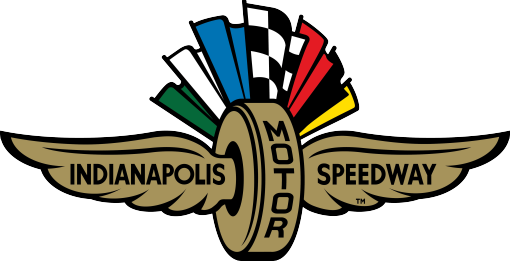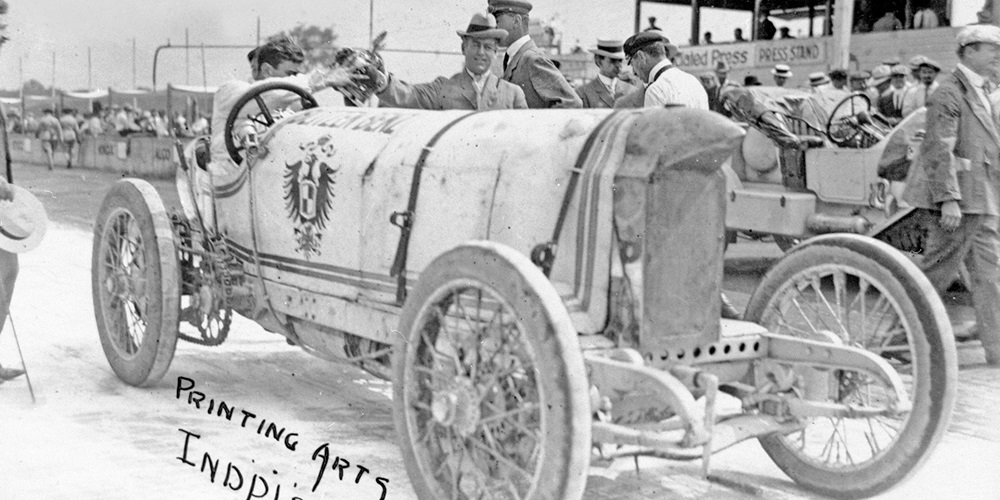One hundred and ten years ago the most powerful, fastest race car on the planet was a 200 horsepower, chain-driven beast with an ominous-sounding name: “The Blitzen Benz.”
Weighing 3,175 pounds, the imposing mechanical marvel boasted a massive four-cylinder engine of 21.5 liters displacement. While manufactured by the Benz Company in Germany nearly 20 years before that firm’s merger with Daimler to create the Mercedes-Benz brand in 1926, the incredible machine is best known for its accomplishments on American soil at two of the country’s venues most synonymous with speed: Daytona Beach and The Racing Capital of the World, the Indianapolis Motor Speedway.
Hard to believe, perhaps, but by 1910 the company German engineer Karl Benz founded in 1883 was 27 years old. Much had changed since his first patented automobile, a spindly, tubular derivative of bicycle chains and wheels with a single cylinder engine barely capable of hitting a top speed of 10 mph had bounded over Mannheim’s cobblestones in the 1880s. The world land speed mile record of 127.660 mph had been set in 1906 at Ormond-Daytona Beach by Frank Marriott in a wooden-bodied steam car from America’s Stanley Brothers. This came about much to the annoyance of an irascible champion racer by the name of Victor Hemery, the star driver of France’s Darracq factory at the time.
Hemery, who had won the Vanderbilt Cup, America’s premier race in 1905, was so frustrated with the thought of losing to a steam-powered contraption he deliberately tried to burn a hole through its body work by positioning his exhaust close to its side when they lined up together at Ormond-Daytona in 1906. The French champion was booted from the competition by officials, and Marriott went on to his great moment in history. By 1909, a determined Hemery had switched allegiance to Benz and was a driving force in a quest to topple the steamer from atop the speed charts. Working with Benz engineers, Hemery soon had at his disposal a masterpiece of technology – the Benz RE, soon to be known as the “Blitzen Benz.”
Pearl white with a pointed-beak brass radiator and black leather hood straps, the beefy machine dazzled all who saw it. Forsaking Daytona, Hemery arrived at Brooklands in England, a 2.75-mile, high-banked, closed-circuit course Nov. 8, 1909 for his shot at bragging rights as the fastest man in the world. The trade magazine The Autocar reported, “Certainly we have never at Brooklands seen a car with such marvelous accelerating capabilities.”
Neither the magazine nor the public would be disappointed. Hemery blasted the world’s most powerful car through time traps set at the kilometer, half-mile and mile marks at remarkable speeds of 125.947, 127.877 and 115.923 mph, respectively. The Benz had demonstrated its awesome power, exceeding Marriott’s top speed, if not claiming the mile record. With the home stretch shorter than a mile, the Brooklands banking proved too challenging for Hemery to hold on at top speed – he had to lift in the turn.
The unpredictable Frenchman, known for emotional outbursts in berating officials and clobbering photographers, uncharacteristically went away satisfied, apparently comfortable that he made his point. Meanwhile his Benz racer had a date with destiny in America, where it was to be paired with the country’s grassroots hero, the legendary Barney Oldfield. By January 1910, it was on display at the Benz Auto Import Company.
Although Oldfield had only been in the sport eight years, the 32-year-old superstar was seen as the grand old man of racing and perhaps past his prime. Suggestions that he had lost his edge were precipitated by his choices of racing venues as much as by his age. Oldfield, long criticized for his appearances in exhibitions at county fair dirt tracks in events viewed more as theater than competition, increasingly encountered skeptics who questioned his skills.
Occasionally Oldfield emerged in serious contests to silence his critics, and this time he reasoned a spectacular feat was required to re-establish his prominence – and his ability to trade on his name as a champion. He also knew there was one accomplishment in racing that was so simple and straightforward anyone could understand: the world record for speed.
Oldfield had followed with interest Hemery’s achievements at Brooklands and knew the massive Benz had been imported to New York. His manager, Ernie Moross, who was also the director of contests at the Indianapolis Motor Speedway, visited the Big Apple in January 1910 to make the purchase. They reportedly closed a deal to acquire the record-setting racer in exchange for an older Benz and $10,000 cash.
The investment proved good as gold when Oldfield appeared at Ormond-Daytona Beach in March. The unique composition of the sands along the coast near Daytona produced a concrete-like surface at the shore’s edge when the tide receded to provide a sun-baked area rendered smooth as a billiard table by the lapping waters. This was a natural speedway and in the earliest days of automobile racing it was regarded as the best place in the world to set records. Since 1904, many of the top manufacturers worldwide had gathered for an annual speed tournament. Oldfield and his massive racer were the big storyline of the meet.
The charismatic driver was an archetypal rugged man with a thick cigar he called his “cheroot” seemingly omnipresent between his clinched teeth. The showman played to the crowd and reporters alike as he prepared for a run at the world land speed records March 16. Ever confident, he proclaimed, “Me and the Benz, we’re going to warm up the sands a little.”
Alone on the beach, Oldfield had to back up all the bravado with results – and he did, becoming the fastest human being on Earth. He shattered Marriott’s 4-year-old record when he hit 131.724 mph for the mile. Hemery’s kilometer mark was blown to smithereens when Oldfield pushed his renamed racer to 131.275 mph for the distance. Oldfield continued down the beach for yet another mile, hitting an amazing 142 mph at 2 miles.
Onlookers gushed, some delirious with enthusiasm over what they had witnessed. Barney Oldfield knew how to feed their frenzy, telling the press: “I let the great machine have its head and for fully a third of the distance the wheels were off the ground while I fought for control. The wheels were shooting up and down in a weird dance. I shot through space in a dark haze and approached the verge of unconsciousness.”
Although the Benz was now a private entry, the Germans were absolutely delighted with the result. Within hours after setting the new mark Oldfield received a telegram from Kaiser Wilhelm that read, “All Germany congratulates the daring Yankee on his accomplishment in a German car.”
Oldfield and Moross embarked on a tour of the country, staging exhibitions for fans clamoring to see the amazing car and its colorful driver. Somewhere along the tour they decided to rename their racer from “Lightning Benz” to “Blitzen Benz,” correctly judging the German term was more compelling.
Among their stops was the Indianapolis Motor Speedway in May 1910 for the first full-scale race meet since the track was paved with bricks the previous autumn. Among the most anticipated events scheduled for the race meet were track record attempts by Oldfield and his Blitzen Benz. Oldfield did not disappoint, delivering record runs of 104.286 mph in the kilometer and 100.897 mph in the mile. At the end of the season, he was presented a gold-plated Overland touring car for his efforts. His fortunes, however, soon changed.
By October, Oldfield and the Blitzen Benz were forced to part ways. The maverick daredevil had a habit of living life on his own terms, which did not sit well with the American Automobile Association (AAA). When he staged an unsanctioned race against heavyweight boxing champion Jack Johnson in October, he was banned from the sport. In a huff, Oldfield sold his interest in the Blitzen Benz to Moross, who soon recruited the lead-footed Bob Burman to fill in as driver.
A striking contrast to Oldfield, Burman was an understated man but seemingly without fear behind the wheel. Despite numerous accidents, his determination to go fast was never deterred. He was a star of the Buick factory team from 1908 through 1910 and on April 22, 1911, he found himself at the wheel of the world’s most powerful car soaring across the vitrified sands of Ormond-Daytona.
The results were breathtaking as Burman toppled Oldfield from the pinnacle of speed with a 141.732-mph run for the mile. The driver described a harrowing ride, reporting that “The Blitzen left the beach for distances of 60 feet at a stretch. One mountainous bump threw me clear out of the seat!”
Again, Moross took the Blitzen Benz on a nationwide tour, and again a highlight was an appearance at the Brickyard. This came the day before the first Indianapolis 500 on May 29, 1911 where Burman shattered the track records Oldfield had established one year prior. Burman hit 104.529 mph for the kilometer and 101.839 mph for the mile. With much fanfare, track officials presented Burman with a huge crown sponsored by Firestone. The driver was introduced to the crowd as the “Speed King.”
In all, there were six Benz RE machines, with at least one restored to pristine condition – in the white livery of the Blitzen Benz – surviving today. Exactly what happened to the Oldfield-Burman car is unknown. But its sister machines continued in active competition in Europe, and especially Brooklands, well into the 1920s to demonstrate outstanding longevity for a truly awesome mechanical specimen from the early days of auto racing.




